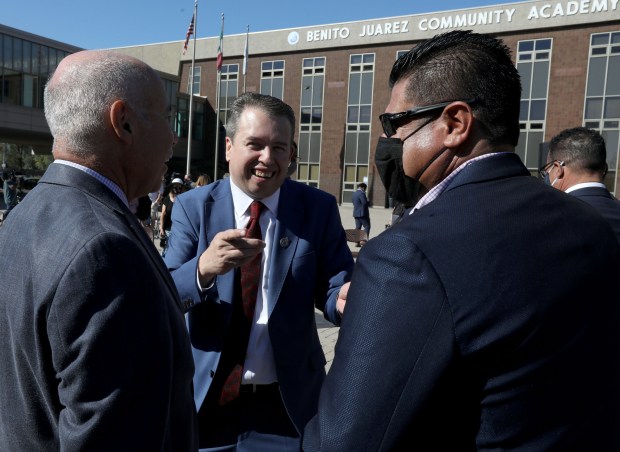New data on Zion Elementary District 6’s measles vaccination rate reveals the district is in a far better position than state data would seem to show, but some schools are still lagging behind.
Previous reporting about the district’s measles protection drew from the Illinois Department of Public Health’s measles outbreak simulator dashboard, which had painted a potentially grim picture for the district.
The new numbers are provided by district leadership and are not reflected in the IDPH’s measles dashboard. Superintendent Julious Lawson said they are the “most current vaccination count” for measles; Beulah Park Elementary at 85.4%, Lakeview School at 92.2%, West Elementary at 94.5%, East Elementary at 96%, Zion Central Middle School at 98%, Shiloh Park Middle School at 98.4% and Elmwood Elementary at 100%.
The new numbers are a redemption for the district compared to the state numbers, although Beulah and Lakeview are still below the recommended levels. Medical experts put the vaccination herd immunity rate for measles at around 95%.
But there are still some potential areas of concern. The percentage of students who have received all required vaccines is very low at nearly all of the district’s schools, according to data Lawson shared. Beulah Park sits at the bottom at 35%, followed by Zion Central at 49%, West at 61%, Lakeview at 64%, Shiloh Park at 64%, Elmwood at 84% and East at 94%.
Leadership looks ahead
Lawson, who recently took over district leadership in July 2024, enters after a brief shakeup in the position. Keely Roberts, who had served as superintendent since 2015, stepped down in 2023 after she and her son were injured during the Highland Park July 4 shooting.
Two interim co-superintendents, Lynette Zimmer and Jim McKay, filled the role prior to Lawson.
He explained that the state requires vaccination data to be sent by Nov. 15, with immunization collection closing Oct.15. Any students not vaccinated by then won’t be counted in that year’s data, and updates are not allowed after the window closes.
Lawson noted that unlike some districts, Zion District 6 doesn’t exclude noncompliant students after the October deadline, which may “lend itself to parents not moving as urgently as necessary.”
While excluding unvaccinated students after the deadline is “being considered,” Lawson said they want to start with “effectively supporting our families and our students.”
“What’s key for me is ensuring that our schools are safe, healthy places for students in Zion to learn,” he said.
There were reporting shortfalls Lawson hoped to address to avoid the vast discrepancies seen between the state’s data and the school’s reality for measles vaccination.
“The takeaway for me … the systems we have for collecting, updating and monitoring this information need to be revisited and adjusted, because they require some ongoing improvements for valid and accurate data to be entered for our students,” he said.
Lawson voiced his commitment to “transparency” and working to “ensure that our immunization data is accurate and current.”
But even in the updated data, some of the schools are still under the advised vaccination rate. Lawson, as a relatively new district leader, said he couldn’t speak to “where the issue began.”
Regardless of the cause for the lower rates seen in some schools and data reporting issues, Lawson said the district has been taking action to address the problems.
That includes plans for monitoring student medical compliance rate, hosting seven additional vaccination clinics specifically offering the MMR vaccination to families with students not in compliance, and additional communications, including daily and weekly letters, emails, texts and even certified mail, he said.
“As a district, we accept full responsibility for where our numbers currently are,” Lawson said.
They’re also working to educate families on the rules regarding religious and medical exemptions. In conversations with families, Lawson said they noted some thought they were religiously exempt but hadn’t filed the correct information.
“We want to make sure that those folks understand the proper documentation required for the approval of claiming to be exempt,” he said.
The district needed to work on its communication with families regarding “our status and provision of information and resources,” he said, “to ensure that we remain transparent as it relates to the vaccination of our students”
Measles and vaccination in the news
On Monday, Health Secretary Robert F. Kennedy Jr. removed all 17 members of the Advisory Committee on Immunization Practices, which advises the Centers for Disease Control and Prevention.
Illinois has had 10 confirmed cases of measles in 2025. While a far cry from the nearly 70 seen in 2024, it’s the second-highest count seen since 2015, according to state data.
In previous reporting, Dr. Jhaveri Ravi, a professor of pediatrics at Northwestern University Feinberg School of Medicine and the division head of pediatric infectious disease at the Ann & Robert H. Lurie Children’s Hospital of Chicago, warned about the risks of dropping vaccination rates against measles.
“It’s probably one of the most contagious agents we deal with,” Ravi said. “Measles tends to find those who are vulnerable.”
Measles infects hundreds of thousands of children each year around the world and kills thousands, he said. The complications can also leave patients vulnerable to other infections.
In the U.S., before the vaccine, children typically got measles because they congregated in large numbers at school. While people who have had measles gain immunity, there can be risks and deadly consequences.
“People tend to say, ‘measles was a rite of passage,’ Ravi said. “I think for maybe the lucky, that was the case. Think about the fact that there’s a price that many other children and families pay.”



